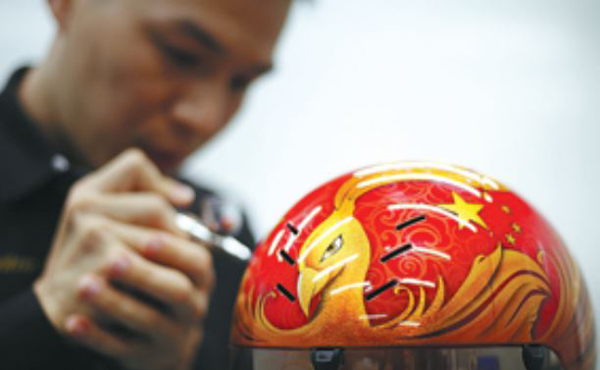Gold medalists' iconic headgear in spotlight

Zhang Dongliang holds a helmet bearing the Feng Ming, or "call of the phoenix" design. ZHENG ERQI/CHINA DAILY
The eye-catching red-and-gold helmets featuring a flying phoenix worn by Chinese women track cyclists came into the spotlight at the Tokyo Olympics.
Cyclists Zhong Tianshi and Bao Shanju were wearing the helmets named Feng Ming, literally the "call of the phoenix", when they won the gold medal in the women's team sprint on the night of Aug 2.
Watching the competition on TV, Zhang Dongliang, the 35-year-old founder of the studio in Guangzhou, Guangdong province, which designed and painted the helmets, waved to celebrate their victory.
"I am excited to see them winning with the helmets we designed. It feels like we have won together and shown the world some traditional Chinese culture," said Zhang, who majored in industrial design at Guangdong University of Technology.
The studio's design integrated traditional Chinese cultural elements into the equipment for the national team. "The phoenix is the king of birds in ancient Chinese legends and has an important place in Chinese culture," he added.
On the helmet, the phoenix flies with the national flag. The underlying patterns include a female role in traditional Chinese operas and on the back is the peony, regarded as an auspicious flower in China.
Notably, a personal touch was incorporated on Bao Shanju's helmet, which, as she wished, had a pattern depicting the ancient city wall of Luoyang, her hometown in Henan province.
On the helmets of the other women cyclists, the city wall was replaced by auspicious clouds, which were also used in the design of the torch for the Beijing Olympic Games in 2008.
The design of the helmets worn by their male counterpart also referred to elements in traditional Chinese opera. These helmets were known as Jue Chen, a wish that the cyclists will take the lead in the same way as ancient brave generals.
Zhang said the helmets were made free of charge to help boost the team's morale and wish them success.
His designs first made a splash at the 2016 Rio Olympics, when he produced customized helmets featuring Peking Opera.
That year, Zhong Tianshi won China's first track cycling gold in the event with partner Gong Jinjie, wearing a helmet designed by Zhang's studio featuring the Peking Opera face makeup of Hua Mulan, an ancient heroic female role.
After the Rio Olympics, Zhong's helmet and that of Gong Jinjie, which features Mu Guiying, another ancient woman warrior, were collected by The Olympic Museum in Lausanne, Switzerland.
A collector called Zhang to offer a high price for helmets with the same designs, but he declined.
"This time we finalized the design in a week, and finished painting them in another week. It was not only some ordinary work, but a mission for us to provide impressive equipment conveying our best wishes and presenting traditional Chinese culture," Zhang said.
Zhang, who is also an amateur cyclist, founded his studio in 2012 in Guangzhou's Panyu district.
The studio works with international and domestic bike brands on the design of bike frames.
In cooperation with a bike manufacturer, Zhang's studio also designed the patterns on some of the bicycles used by Chinese cyclists at the Tokyo Olympics.
Lin Hanxue and Feng Xiaojie contributed to this story.



 Print
Print Mail
Mail

